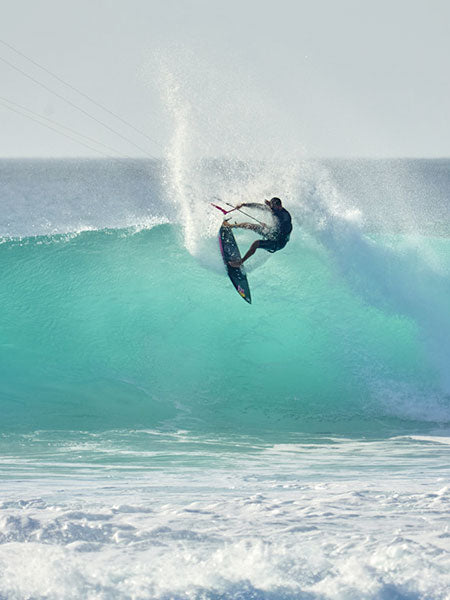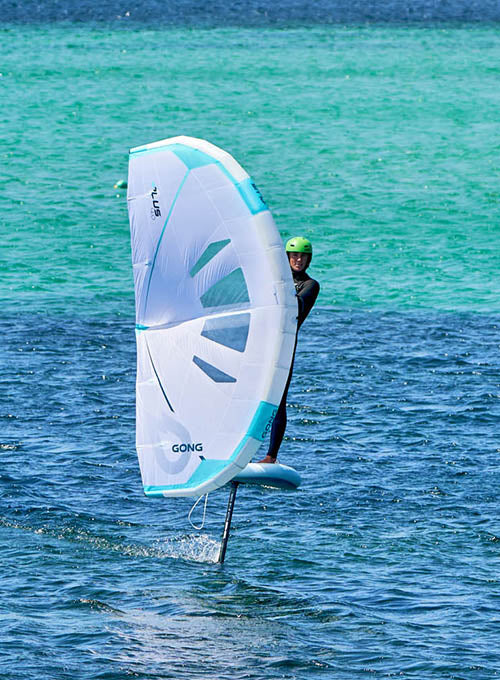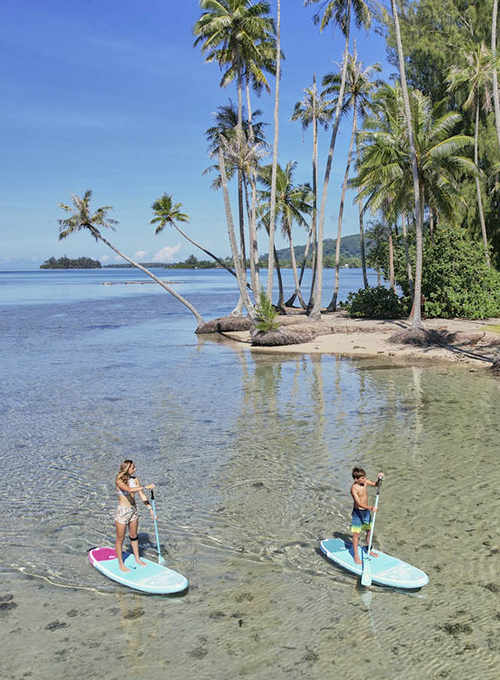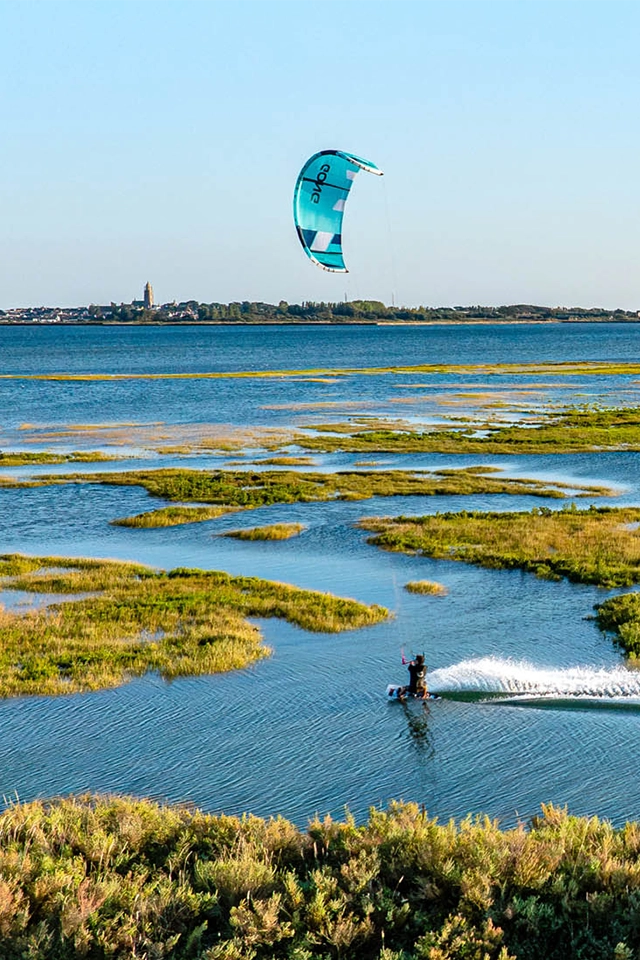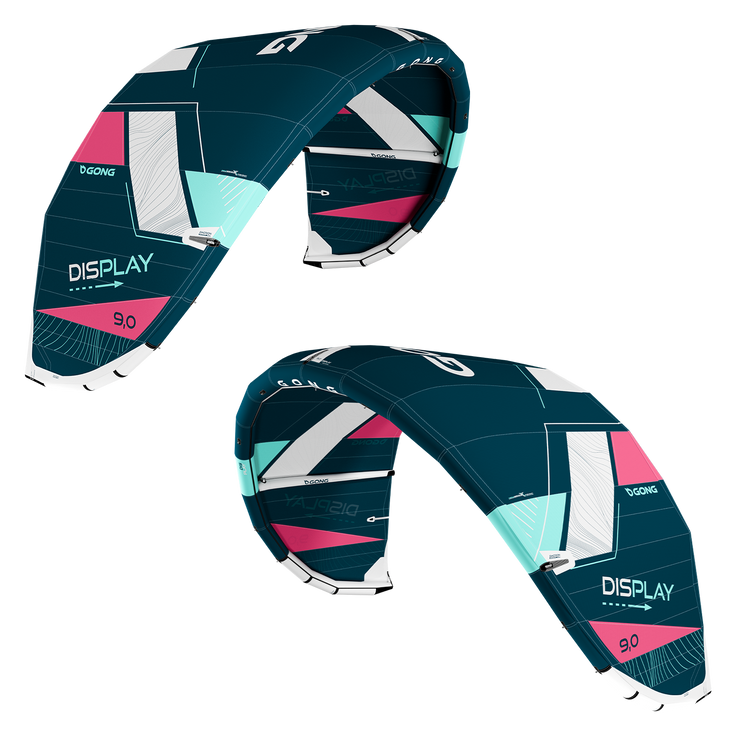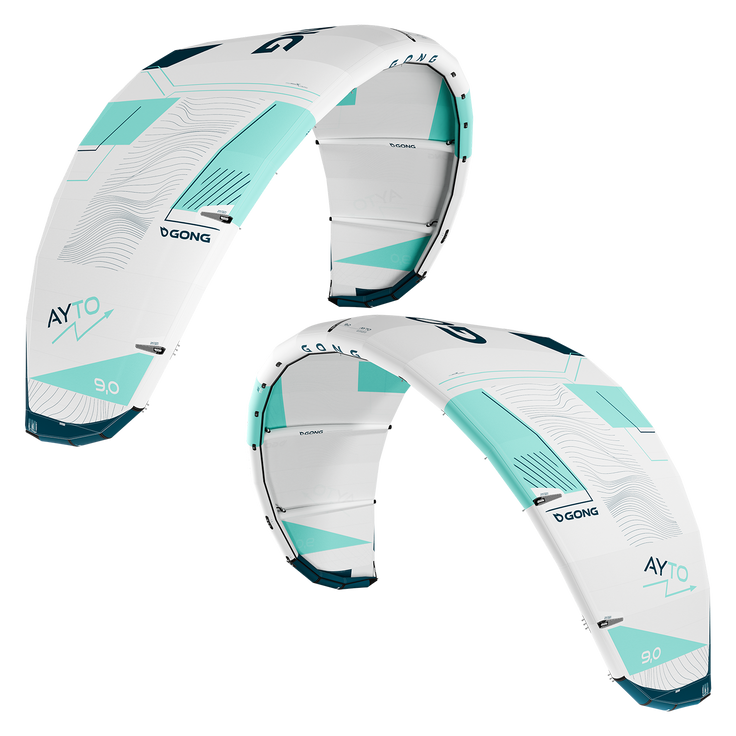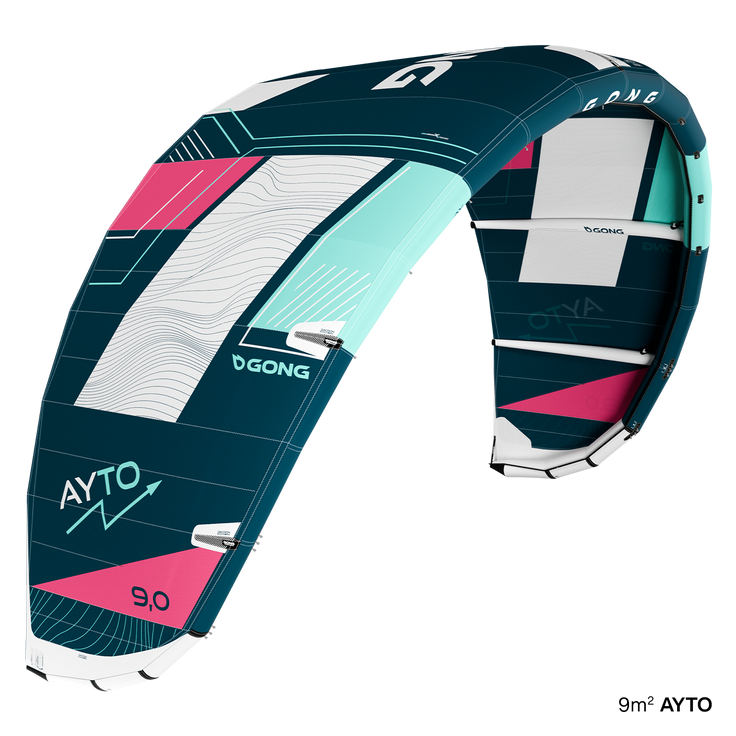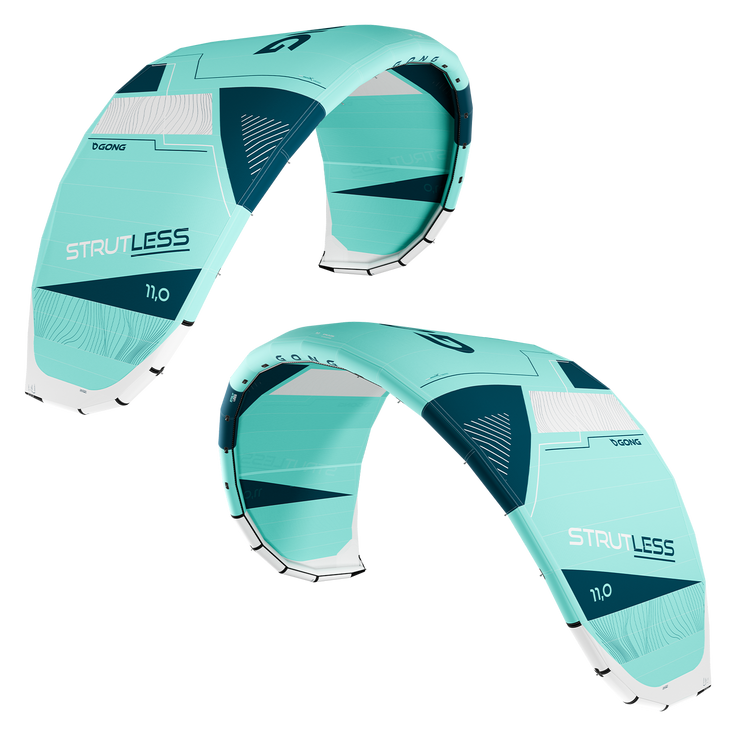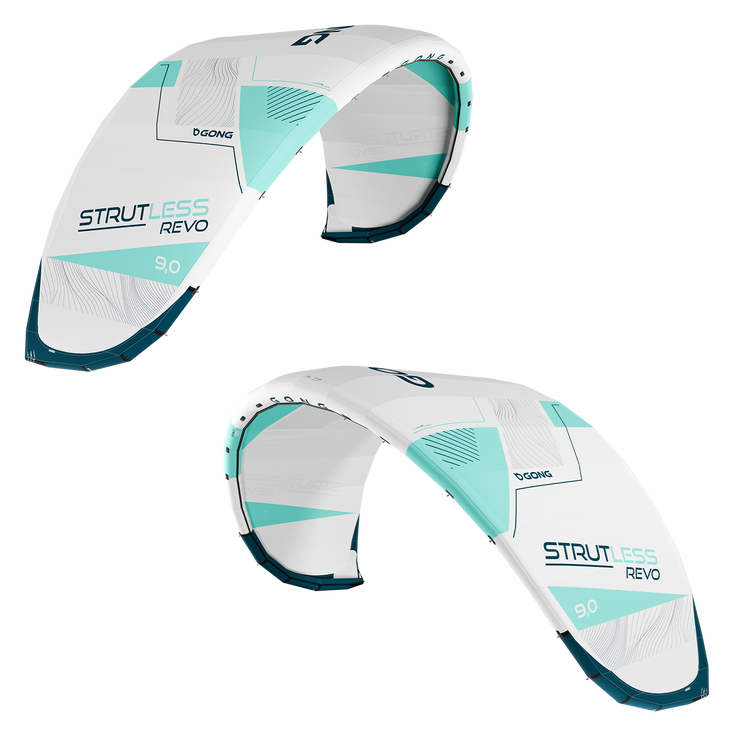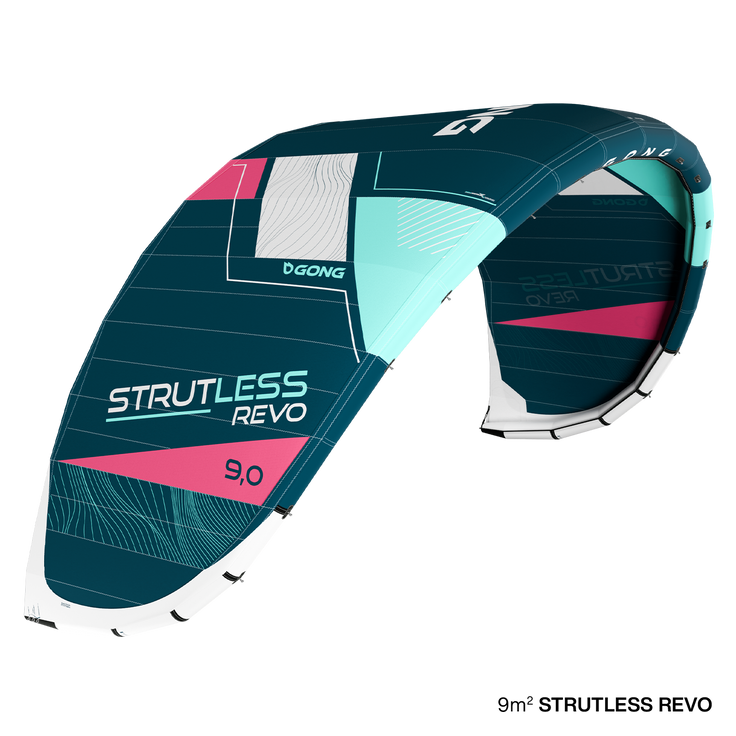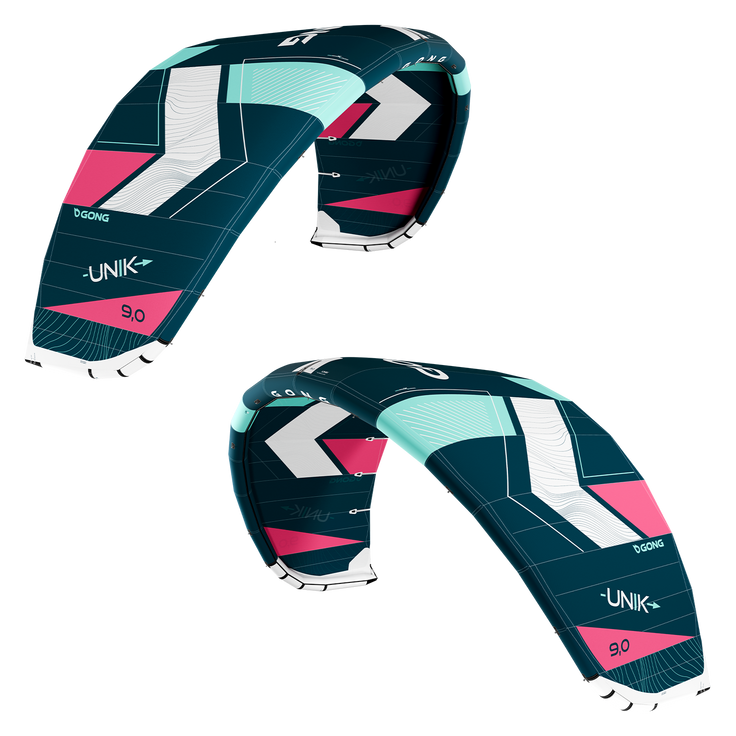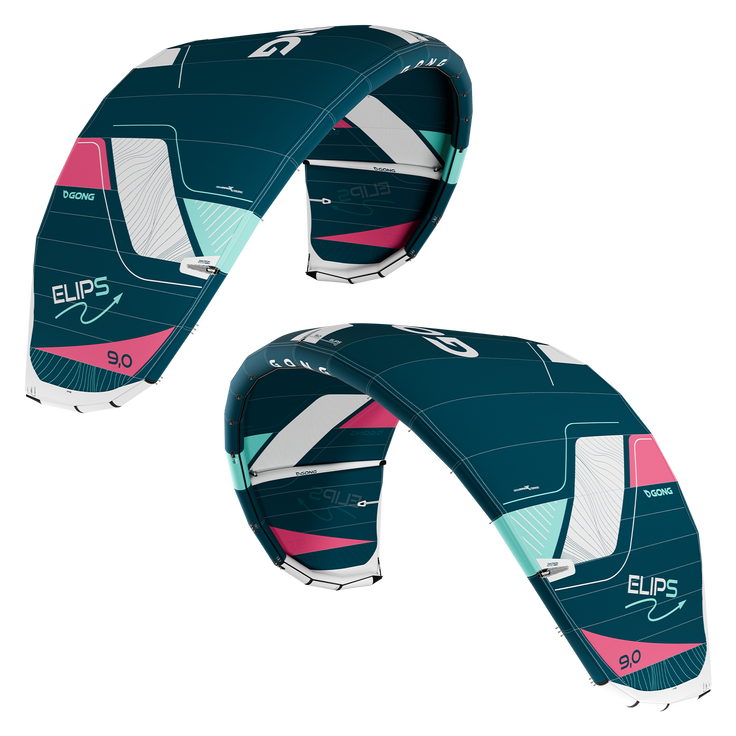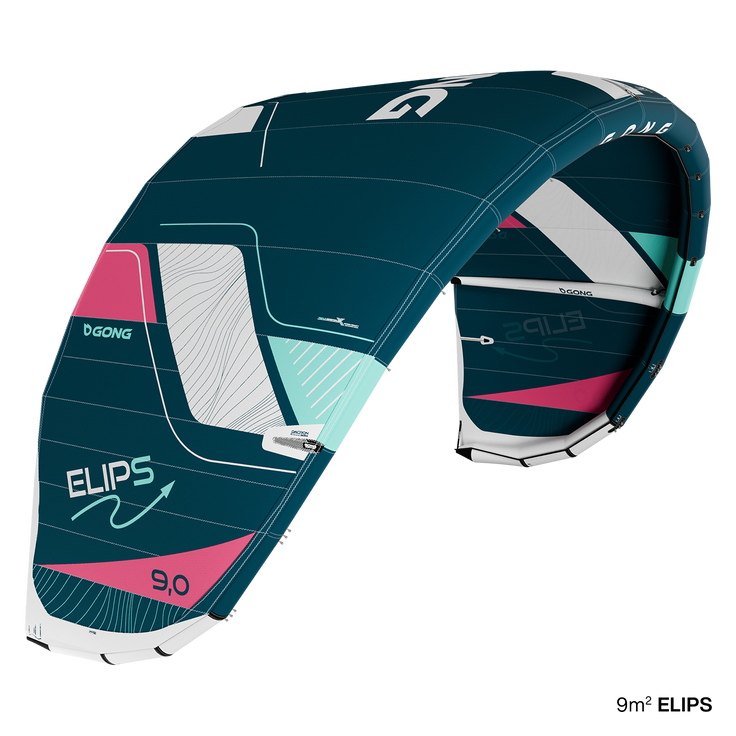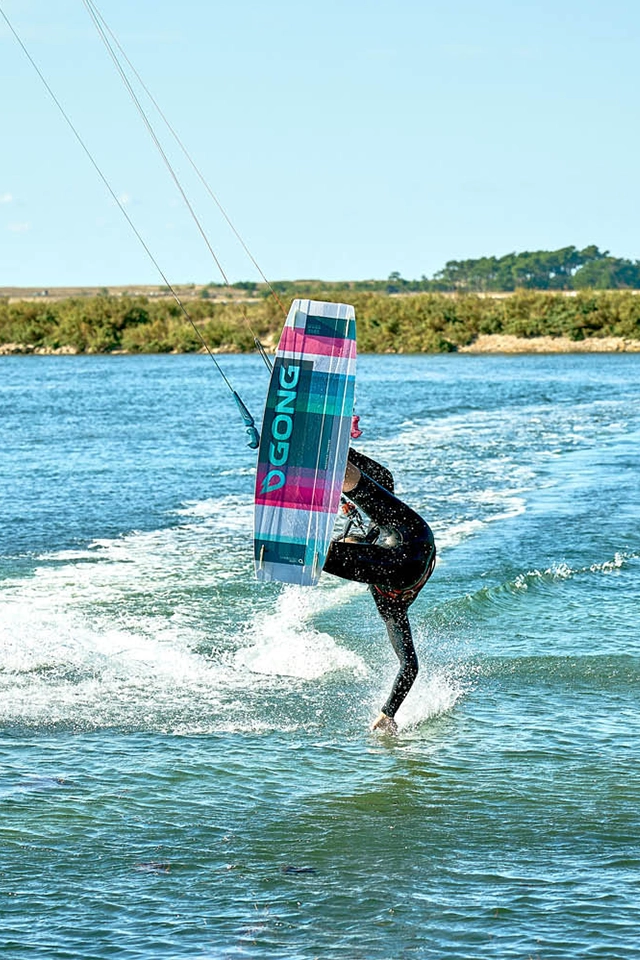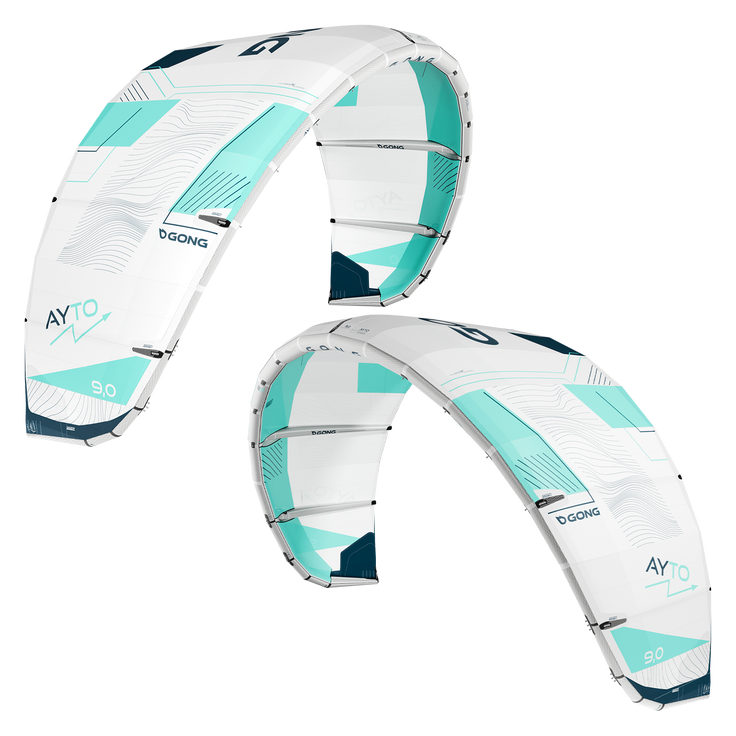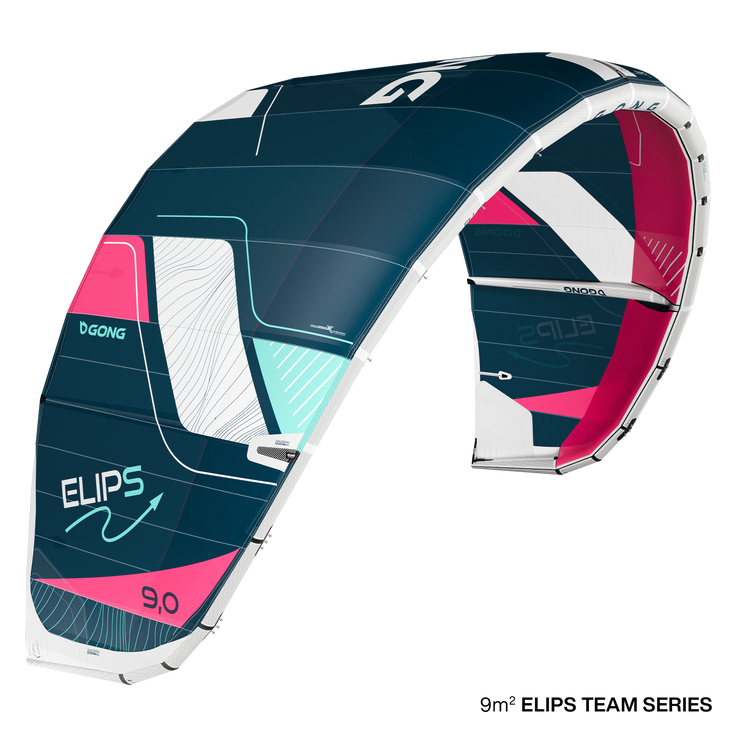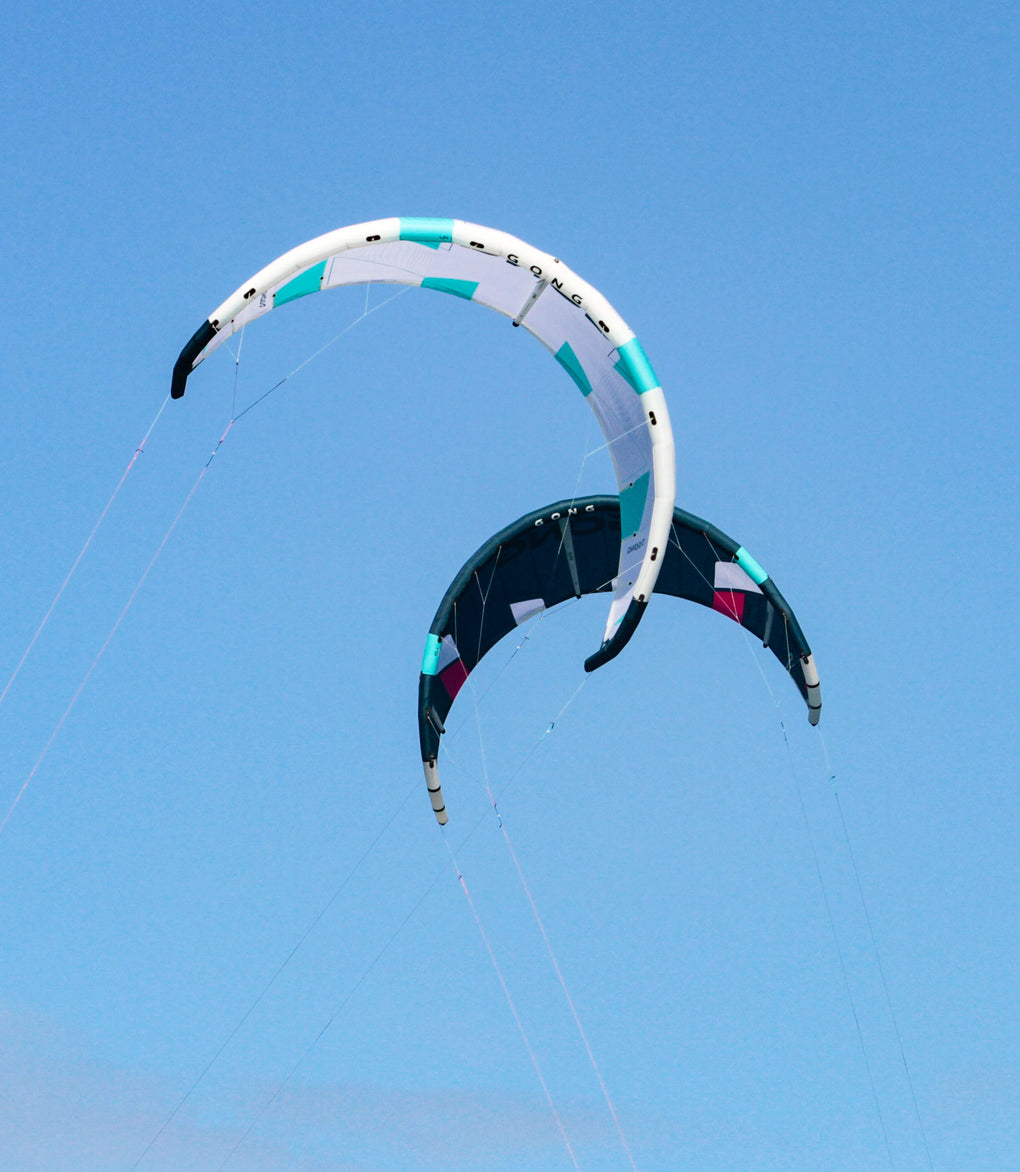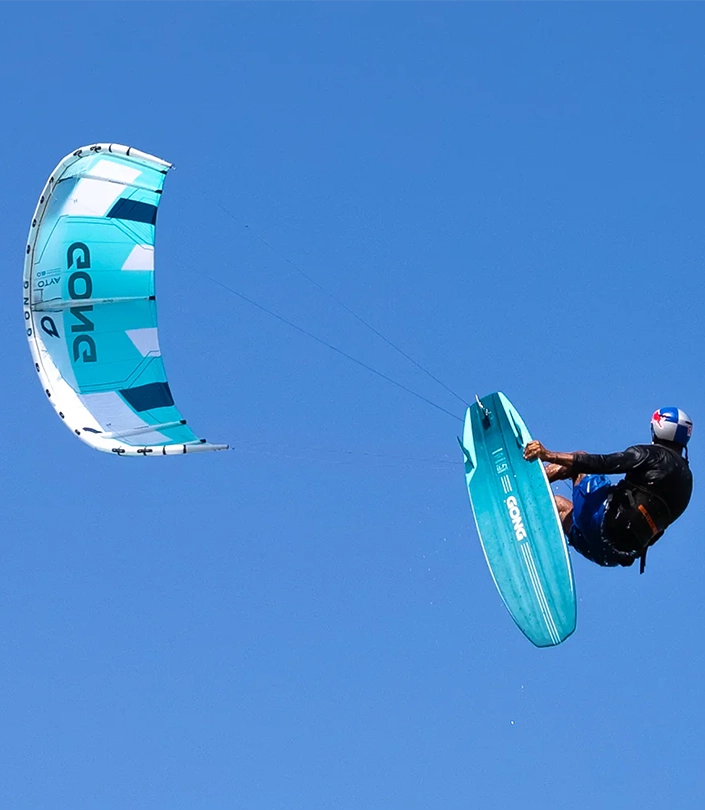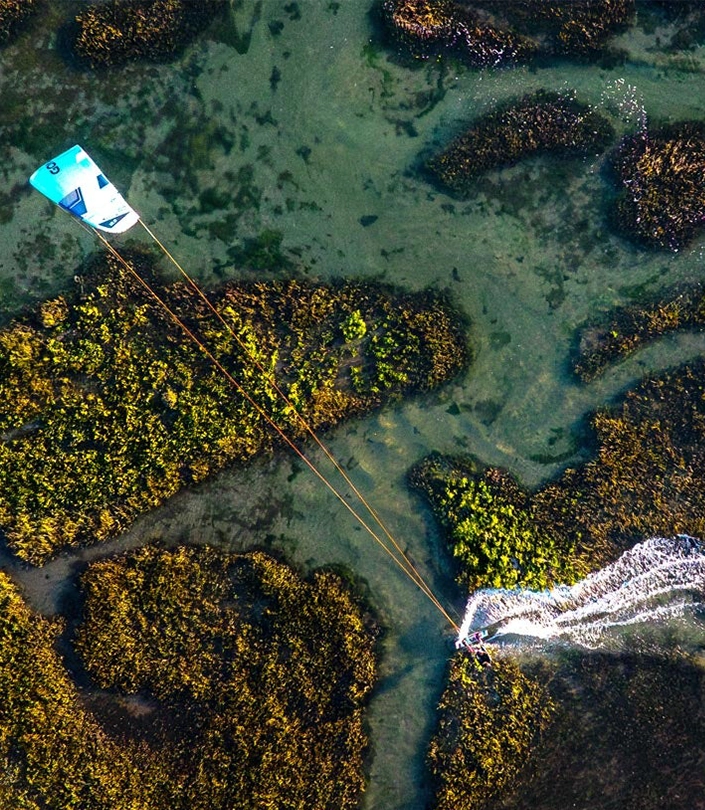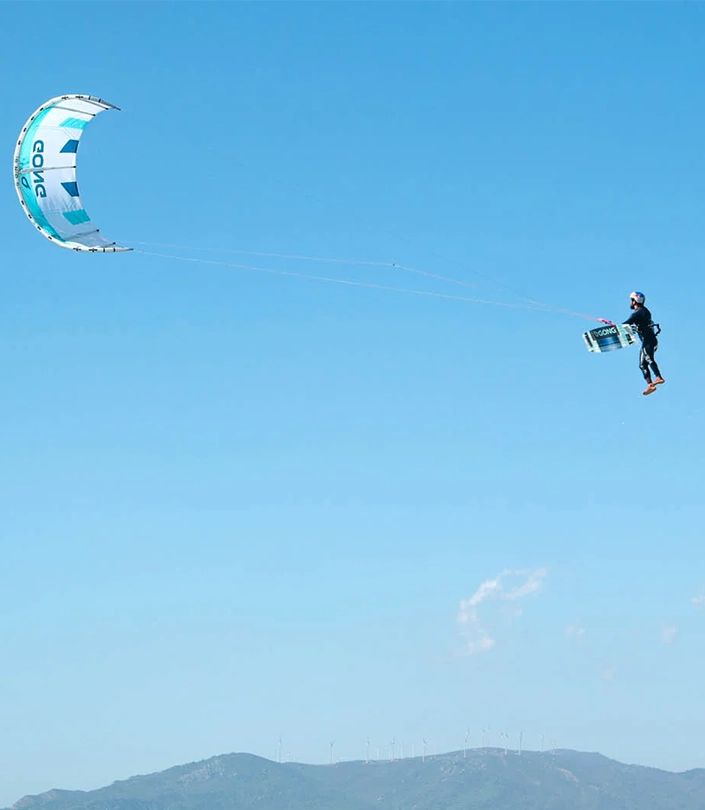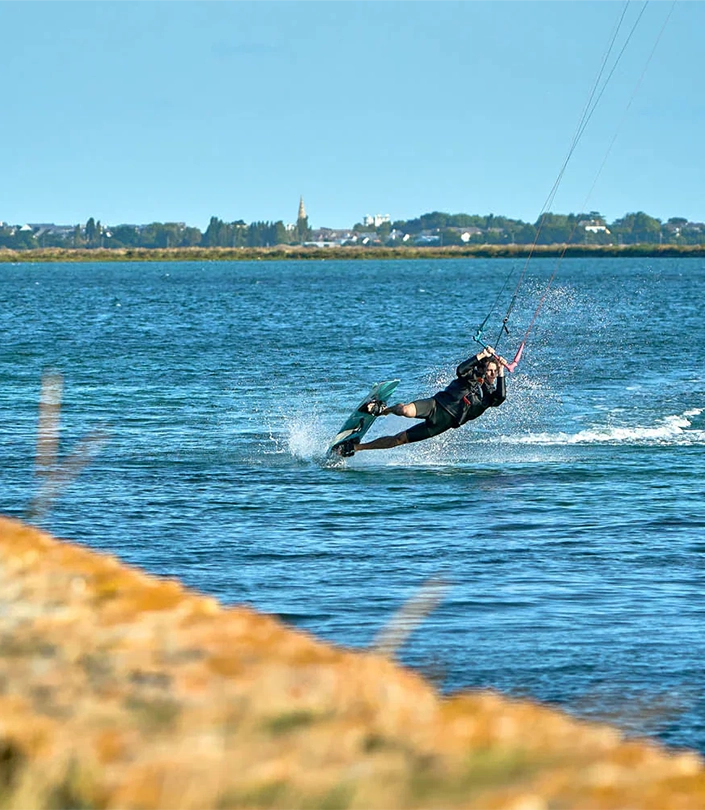Kite Display
Kite Vertigo
Kite Ayto
Kite Strutless
Kite Strutless Revo
Kite Unik
Kite Elips
Kite Ayto Aramid DP Team Series
Elips Aramid DP Team Series Kite
Despite the boom of wing foiling in recent years, the attraction for kitesurfing remains huge with more and more practitioners. The first GONG kite boards date from 1998 and the first kites from 2012, this is a long lasting passion, always part of our quiver for ever more timeless moments on the water. Be it with a twintip, a kite surfboard or a kite foil, the potential of kitesurfing is just incredible.
Below you will find all our explanations and advice allowing you to equip yourself in the best way.
Overview:
Kitesurfing can be learned very quickly even for someone who has never practiced a board or sailing sport. The “Zero to Hero” learning curve (from neophyte to independent rider) is on average around fifteen hours of lessons long. Two hours of lessons per day for a week and you will become an independent kitesurfer!
Our ultra-complete range of kites develops seven models to match the programs of passionate riders of all stripes. From beginners looking for an easy kite to progress, to kitefoilers looking for a super light kite, to kiteloop specialists looking for an ultra-maneuverable kite. Our kite range covers all programs, levels, styles and wind ranges, in a wide choice of sizes from 4m2 to 17m2.
Why choose GONG kites?
Our DNA is simple: create the best possible equipment to go on the water every day, with a huge smile, and share it with as many people as possible.
It’s called LIVE FOR IT.
Our kites are like this:
- efficient
- durable
- all conditions
- all programs
- and with a huge dose of goooood vibes
We are avid practitioners, passionate to the highest degree, creators of our kites, and it is obviously with the greatest care and the greatest investment that we design our kites.
If anything happens to you, we are there: on the other end of the line, immediately available to advise you and repair if necessary. This is the immense strength of a direct relationship: you speak with those who make your kites.
Why are GONG kites so affordably priced?
At GONG, we handle every aspect of our business ourselves. Our commitment to overseeing the entire value chain allows us to optimize each step and reduce costs.
Instead of maximizing our profits, we chose to reduce our margins on kites to encourage more people to kite. Wing foiling has captured a lot of attention, even in manufacturing, but it would be a mistake to miss out on the joy and performance of kitesurfing, which remains fantastic. Dropping prices significantly despite rising costs is our way of encouraging the sport.
Today’s developments in kitesurfing are no longer revolutionary, yet the details sometimes matter more than grand ideas. Details are the foundation of reliability, great feel, and precise handling. Without their designs, kites may look similar, but there are significant differences between them, even within our own lineup.
Saying that R&D costs are enormous for kites is misleading. The efforts are substantial, as seeking micro-evolutions is time-consuming and requires highly specialized experts, but the major research and development for kites was done and validated over a decade ago. Today, we're focused on doing the same for wingfoil, and that, too, requires a significant investment.
Yes, Dacron prices have risen by up to 45% in certain colors. Yes, the factories are overwhelmed with work. Yes, we sold 30% more kites in 2022. And yes, we’re lowering the price of our kites so you can see that our innovations deliver real results on the water.
GONG remains true to its roots: price should not be a barrier to the growth of a sport or to the joy of its enthusiasts!
What are the advantages of kitesurfing today?
Very few water sports offer such a rapid progression. In just a few hours, you become autonomous, and within a few months, you reach a really cool level.
Kitesurfing is not physically demanding. All the power of the kite is absorbed by your harness, and the force required in the arms is minimal. It's very easy to have long, laid-back kite sessions without ending up with burning arms.
The huge advantage of kitesurfing compared to other windsports is its aerial and spectacular aspect. Who hasn't stopped on the beach to watch kiters jumping several meters high? And there's no need for a ramp to get that thrill!
Kiteboarding is highly effective in light wind conditions. Considering that the global average wind speed is 8 knots, practicing a fantastic sport in light air is recommended. Without foil, you can ride comfortably in 8-10 knots, start doing tricks in 10-12 knots, and above 12 knots, it's party time! With a foil, it's even crazier because you can halve those values without needing advanced skills.
Traveling is very easy. Two kites, a board, a bar, a harness, and off you go! It's compact and efficient. What a pleasure to have a 360° view of the spot! You feel weightless because kitesurfing provides almost total lift. Light as a feather. You ride in shallow water. A lagoon, a shallow area before the waves, and boom, it's on fire. And so much more!
Understanding the different programs:
After many years of existence and development, kitesurfing is now a mature sport. The programs are clear and defined, and practitioners have asserted themselves in more technical styles with more specificities.
Gone are the days of "one kite do it all"; time has shown that specific equipment needs predominate. GONG perfectly understands the demands of practitioners to provide a complete range of programs: from beginner to advanced levels, our range has everything to offer you exactly what you need!
FREERIDE EVOLUTION: Progress with an easy, ultra-versatile, and hassle-free kite. When you want to progress quickly, you want equipment that makes life easier. Facilitated upwind riding, constant power, balanced trim, instinctive relaunch, and great stability throughout the flight window.
FREERIDE PERFORMANCE / FREESTYLE: Jack of all trades indeed, but with style! We love versatility AND performance, speed in navigation, height with a good kick at takeoff, maneuverability to charge waves. We want it all but with power and always maintaining a certain accessibility.
HIGH PERFORMANCE BIG AIR / KITELOOPS: Here, we send it! Precise piloting, insane lift, and incredible knack for loops. There's no halfway with this type of program. We want to ride aggressively no matter what we're doing! Reaching crazy heights with the board in hand, pulling off aggressive kite loops, maximizing hang time, full tilt speed runs... We're here to send it without any compromise.
FREERIDE LIGHT WIND: Not all of us are lucky enough to live near a spot with wind stats close to perfection. Light wind or weak thermals shouldn't hinder practice. Light equipment will gain stability in challenging conditions, and that same lightness will enhance maneuverability and bar smoothness! From foil to twin tip, this type of equipment should make complicated conditions simple.
FOIL PERFORMANCE / FREERIDE: Maximum performance in minimal wind. Lightning-fast upwind riding, maximum air glide for maximum speed on the water. Lightness at all levels and always versatile, no matter the support.
FOIL PERFORMANCE / WAVE: Kitefoiling doesn't necessarily mean speed and racing! Nothing beats a strapless board for carving and freestyling on flat water or shredding waves in style with a tiny kite that's ultra-maneuverable and powerful. Sailing on a 5m kite while friends are on a 9 or a 10m is priceless!
WAVE RIDING: The essence of water sports: surfing! We seek instinctive piloting, responsiveness at any moment, and stability throughout the window. We want drift, a kite that follows us and knows how to fade into the background. Power on demand to charge when necessary or escape when we must. Instant relaunch to avoid getting caught in a whole set. In short, we want to surf!

Understanding the different types of kites:
To a beginner, all kitesurfing wings might look the same, but their exact shape, number of struts, or aspect ratio make a significant impact on their behavior and intended use. Visually, the differences might appear minimal, but in practice, they are fundamental.
Aspect Ratios:
The aspect ratio defines how stretched out your kite is, indicating whether it is more round or oval. This stretching directly influences how the kite flies and its performance level. Most of our kites feature “moderate” aspect ratios. Depending on specific needs and the intended use, we adjust the aspect ratio higher or lower.
A higher-aspect kite has a wider wingspan and a narrower chord. Viewed from above (kite laid flat), it appears more elongated, like the Ayto. These kites have less baseline power but move more quickly and, as a result, generate more power per square meter once in motion. They’re responsive to handling, sometimes tricky, with a broad wind window and strong upwind capabilities. Historically used in racing, they are now popular for big air freestyle due to their superior lift and hang time. They are best suited for advanced riders.
While high-aspect ratios offer substantial performance benefits, they require more technical handling and demand good control and anticipation. They are less maneuverable and, depending on the shape, slower to pivot due to their wingspan (as with racing kites). Their large wind window makes them less stable in gusty conditions because they can fly far in the window and risk overshooting the zenith. They are also more challenging to relaunch than low-aspect kites in light wind.
Low-aspect kites are more "stout." They have a more compact shape due to a smaller wingspan and a wider chord. Like our Display or Strutless Revo, these kites have solid baseline power, are very stable, and are easy to handle. They sit deeper in the wind window, giving excellent drift and stability. This type of kite is easier to control, making it ideal for all skill levels and great for freeride or wave riding. The drawbacks of this aspect ratio include lower speed/upwind performance and less lift and hang time.
For these reasons, most of our range revolves around variations with moderate aspect ratios, combining the benefits and minimizing the drawbacks. This factor is indicated in the product specs of each kite as the projection coefficient. The higher it is, the greater the aspect ratio.
To summarize:
- A stout kite (low aspect ratio) like the Strutless Revo is more maneuverable.
- An elongated kite (high aspect ratio) like the Ayto is faster and has excellent lift.
- A kite with a moderate-plus aspect ratio like the Vertigo balances performance and maneuverability well.
- A round kite like the Display or Elips is easy to relaunch.
- A kite with a lot of surface in the center, like the Unik, has more torque.
The number of struts:
Inflatable struts form the skeleton of your kite. Traditionally, more struts meant a "stiffer" kite. Today, with evolving practices and extensive work from designers on shape and bridle development, we've been able to modify the "classic" structures of our kites to reduce or even eliminate struts.
Five-strut kites: Kites like the Ayto generally feature a higher aspect ratio, targeting extreme performance in heavily powered or gusty conditions. That's why they require more struts to stabilize the profile. With these struts, the kite can withstand significant forces and handle aggressive riding.
Three-strut kites: A three-strut kite like the Vertigo has a stabilized profile that performs well even in challenging or overpowered conditions. It's perfect for freeride and strong winds. Three-strut kites offer the best balance between stiffness, weight, maneuverability, and versatility.
Single-strut kites: The Unik, with its single central strut, is lightweight and provides stable flight in light wind. This type of kite is versatile and easy to use for riders of all skill levels. The central strut helps maintain tension in the power zone and aids with relaunching. Ideal for light wind and all-terrain versatility!
Zero-strut kites: With the rise of kite foiling and the need to ride in the lightest wind possible, we developed zero-strut kites like the Strutless and Strutless Revo. The result is maximum weight reduction for a significant performance boost. With no inflatable struts, drag is reduced to a minimum. These kites are generally recommended for intermediate to advanced riders for kite foiling or surf kiting.
Bridles With or Without Pulleys?
To maximize the versatility of our kites, we've developed several types of bridles. Depending on the intended use and desired feel, we use anywhere from zero to three pulleys per side on the front lines.
Each setup caters to specific needs: depower, maneuverability, direct feel, etc.
If we're aiming for maximum versatility with ultra-precise, super-linear control and kite twist, like with the VERTIGO, the three-pulley system is fantastic! Your bridle maintains consistent tension regardless of the kite's position in the wind window. It delivers nearly instant, perfect control with linear power even when the kite is trimmed. Depower capability is at its peak.
For simplicity and forgiveness, a single-pulley bridle is the way to go. It offers significant depower while maintaining a decent kite response. On a kite like the DISPLAY, its simplicity provides reassurance, reduces wear, and significantly increases the sense of safety.
Extreme responsiveness? Zero pulleys! A pulley-less kite sacrifices some forgiveness and smooth handling but gains immense aggressiveness and performance. Our ELIPS and AYTO kites are unapologetically pulley-free, prioritizing responsiveness and reactivity. With fast turns and ultra-precise bar feel, this setup is a game-changer for this kind of program!
Which Freeride Kite Should You Choose?
In our comprehensive range, we offer several freeride kites. Depending on your conditions and skill level, you should lean towards one model over another.
- Display: The ultimate freeride kite, this model is the most versatile regardless of skill level or conditions! With excellent low-end performance and a stable three-strut shape for strong winds, the Display has a broad wind range and unmatched ease of use. Intuitive freeriding, no matter the wind strength.
- Vertigo: High-performance freeride mode! Like the Display and Unik, the Vertigo is great for any discipline. However, with precise handling and consistent power, this kite is best suited for experienced riders. It’s fast, extremely responsive, and delivers an impressive boost in jumps. Freeride, but turbocharged!
- Unik: A freeride kite designed primarily for ease in light or underpowered winds. Its single-strut shape makes it incredibly lightweight and stable throughout the wind window. You'll feel secure even in sub-10-knot conditions. If you frequently ride in low-wind spots and love switching from twin-tip to surfboard to foil, this model is perfect for you!
- Strutless: Light wind enthusiasts will love the Strutless in light or inconsistent wind. With its outstanding glide, you'll have the most efficient kite for marginal conditions without switching to a foil kite, which is usually more complex to handle, especially when it decides to take a dip!
Which Light Wind Kite Should You Choose?
Today, riding in light wind isn't just about going back and forth or struggling to stay upwind with a massive kite overhead. Decades of development have brought performance to a level where a “small” 11m kite can now deliver more power and speed than old 19m kites!
Combine that with the rise of foiling and its highly advanced design, and riding in just 6 knots is not only possible but also incredibly fun! Depending on your usual conditions and riding style, choose from these three models in our extensive range:
- Unik: The most versatile and accessible light wind freeride kite. Whether you're riding twin-tip in 10 knots, surfing small waves with strapless jumps, or going for long runs on a foil, the ultra-light single-strut design and quick relaunch make everything possible. The Unik makes light wind riding fun and accessible.
- Strutless: High-performance freeride/freerace kite. This no-strut model is the pinnacle of glide for an inflatable kite in light wind! Available from 11 to 17m, its moderate aspect ratio and streamlined outline offer the perfect balance of forgiveness and performance. Developed specifically for freerace fans, it goes deep into the wind window without ever stalling due to its well-gripped profile. The upwind angles are insane, and the playground is massive. Get the performance of a foil kite with all the inflatable kite advantages.
- Strutless Revo: Kitefoil carving and surf. The new, ultra-boosted version of the Strutless, the Strutless Revo, features a lower aspect ratio and a wider arc. It's powerful, maneuverable, and lightweight! It's the ideal kite for carving enthusiasts, whether you're on a surfboard or foil. Play with both the kite and board: kiteloops, downloops, rotations—it's all possible, and this kite handles it all! The ultimate light wind carving kite for endless fun on the water.
Which wave kite to choose?
In our ultra-comprehensive range, we have different "wave" kites. Depending on your conditions and level, you should lean towards one model rather than another.
- Display: The freeride kite, excellent for fast progression, is also a very pleasant kite in the waves for its highly stable flight qualities and maneuverability. A very good kite to try surfing without difficulty.
- Vertigo: This high-performance freeride kite is a jack-of-all-trades that will also perform well in the waves with its maneuverability and responsiveness. Its range of use is also an undeniable quality in surfing to avoid being overwhelmed.
- Ayto: 100% big air and kite loops, this kite is extreme. But counterintuitively, it is also excellent in surfing with its supersonic speed and formidable maneuverability. Pro pilot only!
- Unik: This light wind kite and rather underpowered navigation is fantastic in surfing. Firstly because it's so light that you forget about it. Secondly, because it stays glued to the sky, far from punishing you for the slightest piloting error.
- Strutless Revo: The ultimate kite for its maneuverability in foil, it's also delightful for purists in surfing. You kite to surf, and only to surf: that's exactly what it offers.
- Elips: The queen of waves, this kite has everything we love in a kite designed for surfing: maneuverability, stability, resourcefulness, drift, precision, tolerance, incredible low-end range, fine piloting, it's the queen of the spot.
How to choose the bar size?
The choice of your bar size will have a direct impact on the overall feel of your kite. Remember that the longer your bar, the easier it will be to turn your kite. This detail is important when using larger kites, especially in very light wind, to maintain good responsiveness. The longer leverage arm helps compensate for this natural loss of reactivity.
On the contrary, the smaller the kite, the faster it will turn! So, using a smaller bar allows you to balance behaviors and tame the kite's reactions. You should consider these parameters when choosing your bar size and adjust the piloting to the feel you prefer and the conditions encountered.
- If you prefer smooth and progressive piloting, you should "undersize" your bar.
- If you prefer fast and responsive piloting, you should choose a larger bar.
The key size is the 52cm bar. This is the most versatile bar size to choose if you want to have only one bar for a 7-9-12 quiver, or 8-11, or even 8-10-13.
When you have an extended kite quiver, it's best to also equip yourself with a bar quiver to maintain a balanced feel when switching from a small kite to a larger one. Also note that having two bars reduces wear on parts by half!
Here are our recommendations:

The recommendations above are based on the behavior of GONG kites. Since our bars are compatible with a large number of kites, you can adjust your choice according to the type of kite used.
How to choose the length of your lines?
Your FeelX bar comes standard with pre-lines of 80cm, 19m of lines, and 3m extensions already mounted.
The original setup is the most versatile and will be your best choice for 90% of your sessions.
One of the main advantages of the Display is its great tolerance provided by its shape. By playing with its lengths, or even modifying them using our extensions (sold separately), you further enhance its versatility!
- 22m Lines: The "standard" length provides a more progressive and predictable bar feel (recommended setting for progressing kiters). Your flying window will be larger, offering more power at takeoff. This setting is preferred for light to medium wind conditions and for everyday freeride use.
- 19m Lines: Shorter lines offer a more direct kite response, increasing its reactivity. The flying window will be shorter. This setting is perfect for advanced kiters, especially in waves or for foilboarding for added agility.
If you choose to sail with short lines, you will also gain comfort in high wind conditions.
Note that 22m and 19m are not extreme line lengths and remain a fine adjustment to your piloting sensation.
Choosing the Chicken Loop:
To tailor our bar to the widest range of programs and riders' needs, we offer optional chicken loops.
Standard with the bar is the freeride loop, designed to keep the depower trim close to your body, accommodating all sizes while reducing accidental unhooking due to poor positioning of the release. This loop ensures you don't unintentionally oversheet.
For foilers and wave riders using a rope harness, the Slider loop is essential. It allows the loop to slide effortlessly without damaging the rope or the chicken loop.
Note: this loop is required if you use a rope harness, as the standard loop's TPU coating isn't designed for sliding along a rope, which could damage the chicken loop's cover and cut the internal Dyneema.
Wakestylers will find the Freestyle loop a "must-have" for easy hooking and unhooking with its larger loop.
How Are GONG Kites Constructed?

Our kites are made in one of the two largest kite factories worldwide, meeting the highest quality standards. The panels are precision-cut by CNC machines and hand-assembled by the industry's top artisans. We use premium materials that prioritize both performance and durability.
Materials:
- Leading edge and Struts: Dacron DP175LL, providing a rigid frame.
- Trailing edge: Dacron DP175LL for snag resistance and longevity in the wind.
- Canopy: Triple ripstop fabric, highly durable and responsive.
- Insigna reinforcements: Strategically placed on the leading edge for better durability.
- Tips saver: 1680D nylon to protect against abrasion.
- Bridles: Sheathed Dyneema Cousin 2.3mm with LIROS DC701 connections; thin, high-quality, low stretch.
- Removable bridles: Easily replaceable wear parts.
- A4 stainless steel friction rings: Non-jamming and wear-resistant.
- One pump system: For quick inflation and deflation.
- Micro battens: Fiberglass battens on the trailing edge of the tips; lightweight and effective against flapping.
Weight Factors:
Kite weight varies based on three main factors:
- Reinforcements and fabric weight: More reinforcements and heavier fabric increase weight but also crash resistance and longevity.
- Canopy coating: More coating means heavier fabric but greater durability over time. UV exposure and freshwater rinses gradually degrade the coating.
- Bladder thickness: Our 100-micron bladders are among the thickest on the market, providing resistance to unintended over-inflation and frontal impacts.
Which Harness and Other Accessories to Choose:
Seat Harness:
For beginners, starting with a seat harness is highly recommended. This type prevents the typical uncomfortable or even dangerous ride-up of the harness under your armpits after a fall. It also reduces jarring in your spine by distributing the load more evenly around the hips.
Nowadays, seat harnesses are making a comeback for racing and kitefoiling. They're also favored by kiters with back pain due to their enhanced comfort.
Waist Harness:
By far the most widely used harness today, the waist harness is generally preferred for its greater freedom of movement in both surfing and freestyle. Different levels of stiffness are available to suit various rider preferences.
You'll find all our recommendations in our harness buyer's guide.
Impact Vest:
An impact vest is an important safety accessory, regardless of rider level. It ensures peace of mind while starting out, and the added flotation reduces fatigue during essential body-dragging sessions.
Foilers will especially appreciate it when taking high-speed falls from greater heights. And it's invaluable for freestyle kiters skimming across the water.
An impact vest should fit snugly; it will loosen a bit once wet.

Helmets:
Absolutely crucial for beginners, if not mandatory for foiling. Helmets are essential for safety.
We developed our helmet to be as strong and comfortable as possible.
Its design and finish make it high-end:
- Shell: High-density ABS for lightweight strength and durability.
- Interior: EVA foam:
- Double-density for shock absorption.
- Waterproof to prevent waterlogging and weight gain.
- Cold preformed for excellent shape retention.
- Anti-Splash System: Protects your ears without blocking environmental sounds, unlike fully enclosed helmets.
- Our helmet meets the EU 89/686/EEC directive for personal protective equipment and complies with the NF-EN 1385/2012 standard for canoeing and white-water sports helmets.
Through our direct sales system, we keep costs down so safety is affordable!

Usage and Safety Information:
How to maintain your kite:
Unless you finish your session without your kite touching the water for the last 20 minutes, it's quite rare to come out of the water with a completely dry kite.
If you use your kite regularly in saltwater, there’s no need to dry it. Saltwater actually helps protect the material from mold. Nor should you rinse it with fresh water after each session; chlorine and pH levels in fresh water can damage the fabric more than saltwater.
Never leave your kite exposed to the sun for hours, as UV rays are the primary cause of premature aging. Also, don't leave it flapping in the wind, as this significantly shortens its lifespan. Be mindful of any remaining sand, which acts like sandpaper, rubbing against the fabric and damaging the seams. It's strongly recommended to pack your kite with as little sand as possible.
If you're not kiting for an extended period, store the kite clean in a dry place.
Perform regular checkups on your kite to catch any issues early and prevent major repairs. It's also crucial to inspect your bar frequently for safety.
Safety first.
How to Relaunch Your Kite in Less Than 10 Knots:
Right of way rules in kiteboarding:
Kiteboarding, like other water sports such as surfing, has its own etiquette. Following these rules is crucial to avoid collisions and ensure a smooth, safe, and enjoyable session for everyone.
Here's a summary of the basics:
- The kitesurfer launching from the beach has the right of way. Those heading ashore must yield by sailing downwind or turning back.
- When two kitesurfers are about to cross paths, the kitesurfer riding to the right has the right of way and must raise their kite. The kitesurfer going left should yield by lowering their kite and heading downwind to avoid entanglement.
- Faster kitesurfers do not have the right of way. They should either pass downwind or turn back.
- A kitesurfer riding a wave has the right of way. The first person on the wave and closest to the breaking point has priority. Ethically, surfers have priority over kitesurfers.
- For a jump, you need at least 50 meters of clear space downwind and 30 meters upwind to avoid collisions or tangling with other riders.
Kitesurfing safety:
Safety in kitesurfing is crucial. No session is worth risking your life. Be aware of the potential dangers and minimize them by following proper behavior.
Here are some recommendations for a safer kiting experience:
- Protect yourself in case of a fall:
Always put your hands and arms in front of your face and head. One day, this will save you from stitches. A helmet and impact vest are strongly recommended!
- Protect others:
Don't head onto a wave with multiple people and follow the right-of-way rules. Even if you have priority, you must still avoid collisions. Don't rush toward others or pass too close, thinking it'll work out.
- Never grab the lines of a crashed kite:
If it relaunches, the lines can slice through your fingers in a split second. A line wrapped around your fingers happens fast, not to mention burns from friction.
- Don't let your kite crash:
A kite is meant to fly—its fall should be a warning sign. It's not normal for it to end up in the water, let alone worse if it falls onshore or on people. Extremely dangerous.
- Don't trim for takeoff:
Some fully trim their kites to reduce power but also lose control because the back lines become slack. The kite becomes a limp bag, making you more vulnerable than if it had more power. If you must trim to take off, you probably shouldn't be launching that kite.
- Don't let a non-kiter help you:
This can endanger everyone. Ask people about their kite skills before accepting their help.
If in doubt:
If you're unsure about the conditions or your skill level, don't take off. If in doubt, stay out!
How to install optional battens on strutless kites:
The Strutless and Strutless Revo models are equipped with fiber battens that improve stability at high speeds. They enhance the high-end wind range, upwind performance, and relaunch.
Insert the battens into the sleeves through the trailing edge like a windsurf sail and secure them with a Velcro strap. This routine is quick and easy. Just remember two important points:
- Insert Before Inflation: The battens must be inserted before inflating the kite; otherwise, you won't be able to fully insert them into the batten sleeve.
- Position in Wind Direction: If you're inflating in a windy area, unroll the kite in the wind direction so that one tip is upwind, and the other is downwind, with the upper surface facing the sand. Place sand on the upwind tip to hold the kite in place, allowing you to insert the battens easily.
After that, inflate your kite normally. This will reduce drag by 30%, which is incredible for performance. Finally, inflate the leading edge.
How to Maintain Your Pump:
Learn more here: Pump Maintenance Guide
More Info on Our Forum: Click Here


